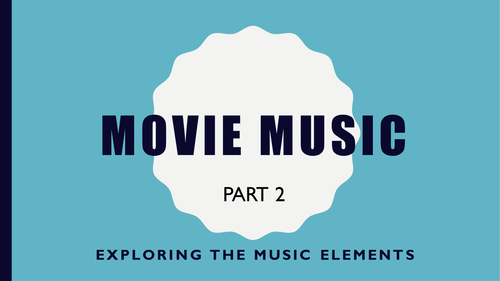
Following the introductory 'Movie music' Part 1, this lesson continues to engage learners and is good for developing listening vocabulary and aural skills. The scaffolded pptx. picks one musical element (pitch for instance) and has students watch and listen to selected, short film clips using the Trailer from the Justice League Official Comic-Con (2017) movie. To begin, students focus on just one music element. Then, they listen again focusing on a different musical element. This pptx. gives short guides on each music element for students to copy and use as they watch and listen. The guides can be reused many times as general notes for listening skills in other topics. This exercise is engaging, promotes discussion and skilfully has students listening over and over with a focus on each element as they practise their skills. They won’t know how hard they are working!
This lesson builds listening skills and helps students meet ACARA Year 7 and 8 Achievement Standard:
"By the end of Year 8, students identify and analyse how the elements of music are used in different styles and apply this knowledge in their performances and compositions. They evaluate musical choices they and others from different cultures, times and places make to communicate meaning as performers and composers." http://www.australiancurriculum.edu.au/the-arts/music/curriculum
Generally meets outcomes for:
Enquiring – identifying, exploring and organising information and ideas
• Identify and clarify information and ideas
• Organise and process information
Generating ideas, possibilities and actions
• Imagine possibilities and connect ideas
• Consider alternatives
Reflecting on thinking and processes
• Think about thinking (metacognition)
• Reflect on processes
Analysing, synthesising and evaluating reasoning and procedures
• Draw conclusions
• Analyse composers’ use of the elements of music and stylistic features when listening to and interpreting music.
• identifying elements of music aurally and then discussing how these elements, composition techniques and devices are used and manipulated to create a style.
• accessing and researching music through real or virtual performances to analyse performers’ interpretations of composers’ intentions
This lesson builds listening skills and helps students meet ACARA Year 7 and 8 Achievement Standard:
"By the end of Year 8, students identify and analyse how the elements of music are used in different styles and apply this knowledge in their performances and compositions. They evaluate musical choices they and others from different cultures, times and places make to communicate meaning as performers and composers." http://www.australiancurriculum.edu.au/the-arts/music/curriculum
Generally meets outcomes for:
Enquiring – identifying, exploring and organising information and ideas
• Identify and clarify information and ideas
• Organise and process information
Generating ideas, possibilities and actions
• Imagine possibilities and connect ideas
• Consider alternatives
Reflecting on thinking and processes
• Think about thinking (metacognition)
• Reflect on processes
Analysing, synthesising and evaluating reasoning and procedures
• Draw conclusions
• Analyse composers’ use of the elements of music and stylistic features when listening to and interpreting music.
• identifying elements of music aurally and then discussing how these elements, composition techniques and devices are used and manipulated to create a style.
• accessing and researching music through real or virtual performances to analyse performers’ interpretations of composers’ intentions
Something went wrong, please try again later.
This resource hasn't been reviewed yet
To ensure quality for our reviews, only customers who have purchased this resource can review it
Report this resourceto let us know if it violates our terms and conditions.
Our customer service team will review your report and will be in touch.
£4.00
